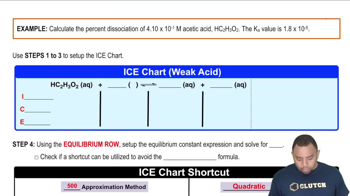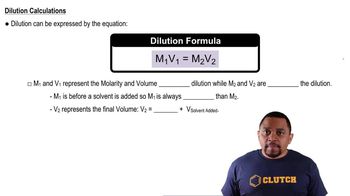Here are the essential concepts you must grasp in order to answer the question correctly.
Percent Dissociation
Percent dissociation refers to the fraction of a weak acid or base that ionizes in solution, expressed as a percentage. For example, if 1 mole of HF dissociates into 0.3 moles of H+ and F-, the percent dissociation would be (0.3/1) * 100 = 30%. Understanding this concept is crucial for determining how dilution affects the ionization of the acid.
Recommended video:
Percent Dissociation Example
Dilution and Concentration
Dilution is the process of reducing the concentration of a solute in a solution, typically by adding more solvent. The relationship between the initial and final concentrations and volumes is given by the equation C1V1 = C2V2, where C is concentration and V is volume. This principle is essential for calculating the new volume required to achieve a desired percent dissociation.
Recommended video:
Equilibrium Constant (Ka)
The equilibrium constant (Ka) for a weak acid quantifies its strength and the extent of dissociation in solution. It is defined as the ratio of the concentration of the products to the concentration of the reactants at equilibrium. For HF, the Ka value helps predict how changes in concentration, such as dilution, will affect the degree of ionization and thus the percent dissociation.
Recommended video:




